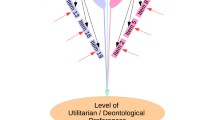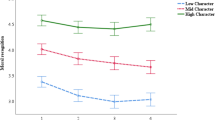Abstract
Although various motives underlie moral decision-making, recent research suggests that deontological moral decision-making may have evolved, in part, to communicate trustworthiness to conspecifics, thereby facilitating cooperative relations. Specifically, social actors whose decisions are guided by deontological (relative to utilitarian) moral reasoning are judged as more trustworthy, are preferred more as social partners, and are trusted more in economic games. The current study extends this research by using an alternative manipulation of moral decision-making as well as the inclusion of target facial identities to explore the potential role of participant and target sex in reactions to moral decisions. Participants viewed a series of male and female targets, half of whom were manipulated to either have responded to five moral dilemmas consistent with an underlying deontological motive or utilitarian motive; participants indicated their liking and trust toward each target. Consistent with previous research, participants liked and trusted targets whose decisions were consistent with deontological motives more than targets whose decisions were more consistent with utilitarian motives; this effect was stronger for perceptions of trust. Additionally, women reported greater dislike for targets whose decisions were consistent with utilitarianism than men. Results suggest that deontological moral reasoning evolved, in part, to facilitate positive relations among conspecifics and aid group living and that women may be particularly sensitive to the implications of the various motives underlying moral decision-making.
Similar content being viewed by others
References
Baron, J., Scott, S., Fincher, K., & Metz, S. E. (2015). Why does the cognitive reflection test (sometimes) predict utilitarian moral judgment (and other things)? Journal of Applied Research in Memory and Cognition, 4, 265–284.
Bartels, D. M., & Pizarro, D. A. (2011). The mismeasure of morals: antisocial personality traits predict utilitarian responses to moral dilemmas. Cognition, 121, 154–161.
Bleske-Rechek, A., Remiker, M. W., Swanson, M. R., & Zeug, N. M. (2006). Women more than men attend to indicators of good character: two experimental demonstrations. Evolutionary Psychology, 4, 248–261.
Conway, P., & Gawronski, B. (2013). Deontological and utilitarian inclinations in moral decision making: a process decision approach. Journal of Personality and Social Psychology, 104, 216–235.
Cosmides, L., & Tooby, J. (2006). Evolutionary psychology, moral heuristics, and the law. In G. Gigerenzer & C. Engel (Eds.), Heuristics and the law (pp. 175–205). Berlin: Dahlem University Press.
Cottrell, C. A., Neuberg, S. L., & Li, N. P. (2007). What do people desire in others? A sociofunctional perspective on the importance of different valued characteristics. Journal of Personality and Social Psychology, 92, 208–231.
Darwin, C. (1874). The descent of man and selection in relation to sex. New York: Rand, McNally & Company.
Djeriouat, H., & Trémolière, B. (2014). The dark triad of personality and utilitarian moral judgment: the mediating role of honesty/humility and harm/care. Personality and Individual Differences, 67, 11–16.
Everett, J. A., Pizarro, D. A., & Crockett, M. J. (2016). Inference of trustworthiness from intuitive moral judgments. Journal of Experimental Psychology: General, 145, 772–787.
Faul, F., Erdfelder, E., Lang, A. G., & Buchner, A. (2007). G*Power 3: a flexible statistical power analysis program for the social, behavioral, and biomedical sciences. Behavior Research Methods, 39, 175–191.
Friesdorf, R., Conway, P., & Gawronski, B. (2015). Gender differences in response to moral dilemmas: a process dissociation analysis. Personality and Social Psychology Bulletin, 41, 696–713.
Graham, J., Nosek, B. A., Haidt, J., Iyer, R., Koleva, S., & Ditto, P. H. (2011). Mapping the moral domain. Journal of Personality and Social Psychology, 101, 366–385.
Greene, J. D. (2009). The cognitive neuroscience of moral judgment. The Cognitive Neurosciences, 4, 1–48.
Greene, J. D., Sommerville, R. B., Nystrom, L. E., Darley, J. M., & Cohen, J. D. (2001). An fMRI investigation of emotional engagement in moral judgment. Science, 293, 2105–2108.
Greene, J. D., Nystrom, L. E., Engell, A. D., Darley, J. M., & Cohen, J. D. (2004). The neural bases of cognitive conflict and control in moral judgment. Neuron, 44, 389–400.
Haidt, J. (2001). The emotional dog and its rational tail: a social intuitionist approach to moral judgment. Psychological Review, 108, 814–834.
Haselton, M. G., & Buss, D. M. (2000). Error management theory: a new perspective on biases in cross-sex mind reading. Journal of Personality and Social Psychology, 78, 81–91.
Jonason, P. K., Li, N. P., Webster, G. D., & Schmitt, D. P. (2009). The dark triad: facilitating a short‐term mating strategy in men. European Journal of Personality, 23, 5–18.
Jordan, J. J., Hoffman, M., Nowak, M. A., & Rand, D. G. (2016). Uncalculating cooperation is used to signal trustworthiness. Proceedings of the National Academy of Sciences, 113, 8658–8663.
Kant, I. (1785/1959). Foundation of the metaphysics of morals. [Grundlegung zur Metaphysik der Sitten]. (L. W. Beck, Trans.) Indianapolis: Bobbs-Merrill.
Kawakami, K., Phills, C. E., Steele, J. R., & Dovidio, J. F. (2007). (Close) distance makes the heart grow fonder: improving implicit racial attitudes and interracial interactions through approach behaviors. Journal of Personality and Social Psychology, 92, 957–971.
Koop, G. J. (2013). An assessment of the temporal dynamics of moral decisions. Judgment and Decision Making, 8, 527–539.
Krebs, D. L. (2008). Morality: an evolutionary account. Perspectives on Psychological Science, 3, 149–172.
Kreps, T. A., & Monin, B. (2014). Core Values Versus Common Sense Consequentialist Views Appear Less Rooted in Morality. Personality and Social Psychology Bulletin, 40, 1529–1542.
Lilienfeld, S. O., Waldman, I. D., Landfield, K., Watts, A. L., Rubenzer, S., & Faschingbauer, T. R. (2012). Fearless dominance and the US presidency: implications of psychopathic personality traits for successful and unsuccessful political leadership. Journal of Personality and Social Psychology, 103, 489–505.
Lucas, B. J., & Galinsky, A. D. (2015). Is utilitarianism risky? How the same antecedents and mechanism produce both utilitarian and risky choices. Perspectives on Psychological Science, 10, 541–548.
Mill, J. S. (1861/1998). Utilitarianism. New York: Oxford University Press.
Minear, M., & Park, D. C. (2004). A lifespan database of adult facial stimuli. Behavior Research Methods, Instruments, & Computers, 36, 630–633.
Montoya, R. M., & Horton, R. S. (2004). On the importance of cognitive evaluation as a determinant of interpersonal attraction. Journal of Personality and Social Psychology, 86, 696–712.
Montoya, R. M., & Horton, R. S. (2014). A two-dimensional model for the study of interpersonal attraction. Personality and Social Psychology Review, 18, 59–86.
Montoya, R. M., & Insko, C. A. (2008). Toward a more complete understanding of the reciprocity of liking effect. European Journal of Social Psychology, 38, 477–498.
Neuberg, S. L., Kenrick, D. T., & Schaller, M. (2011). Human threat management systems: self-protection and disease avoidance. Neuroscience & Biobehavioral Reviews, 35, 1042–1051.
O’Neill, P., & Petrinovich, L. (1998). A preliminary cross-cultural study of moral intuitions. Evolution and Human Behavior, 19, 349–367.
Patil, I. (2015). Trait psychopathy and utilitarian moral judgement: the mediating role of action aversion. Journal of Cognitive Psychology, 27, 349–366.
Rempel, J. K., Ross, M., & Holmes, J. G. (2001). Trust and communicated attributions in close relationships. Journal of Personality and Social Psychology, 81, 57–64.
Rezlescu, C., Duchaine, B., Olivola, C. Y., & Chater, N. (2012). Unfakeable facial configurations affect strategic choices in trust games with or without information about past behavior. PloS One, e34293.
Rom, S. C., Weiss, A., & Conway, P. (2016). Judging those who judge: perceivers infer the roles of affect and cognition underpinning others’ moral dilemma responses. Journal of Experimental Social Psychology.
Sacco, D. F., Young, S. G., & Hugenberg, K. (2014). Balancing competing motives: adaptive trade-offs are necessary to satisfy disease avoidance and interpersonal avoidance goals. Personality and Social Psychology Bulletin, 40, 1611–1623.
Sacco, D. F., Lustgraaf, C. J. N., Brown, M., & Young, S. G. (2015). Activation of self-protection threat increases women’s preferences for dominance in male faces. Human Ethology Bulletin, 30, 24–32.
Sell, A., Hone, L. S., & Pound, N. (2012). The importance of physical strength to human males. Human Nature, 23, 30–44.
Snyder, J. K., Fessler, D. M., Tiokhin, L., Frederick, D. A., Lee, S. W., & Navarrete, C. D. (2011). Trade-offs in a dangerous world: women’s fear of crime predicts preferences for aggressive and formidable mates. Evolution and Human Behavior, 32, 127–137.
Trémolière, B., Kaminski, G., & Bonnefon, J. F. (2014). Intrasexual competition shapes men’s anti-utilitarian moral decisions. Evolutionary Psychological Science, 1, 18–22.
Trivers, R. L. (1971). The evolution of reciprocal altruism. Quarterly Review of Biology, 46, 35–57.
Williams, K. D., Forgas, J. P., & Von Hippel, W. (Eds.). (2005). The social outcast: ostracism, social exclusion, rejection, and bullying. Psychology Press.
Acknowledgments
We thank Aaron Bermond, Seth Bridges, and Savannah Merold for their contributions to the data collection for this study.
Author information
Authors and Affiliations
Corresponding author
Rights and permissions
About this article
Cite this article
Sacco, D.F., Brown, M., Lustgraaf, C.J.N. et al. The Adaptive Utility of Deontology: Deontological Moral Decision-Making Fosters Perceptions of Trust and Likeability. Evolutionary Psychological Science 3, 125–132 (2017). https://doi.org/10.1007/s40806-016-0080-6
Published:
Issue Date:
DOI: https://doi.org/10.1007/s40806-016-0080-6




